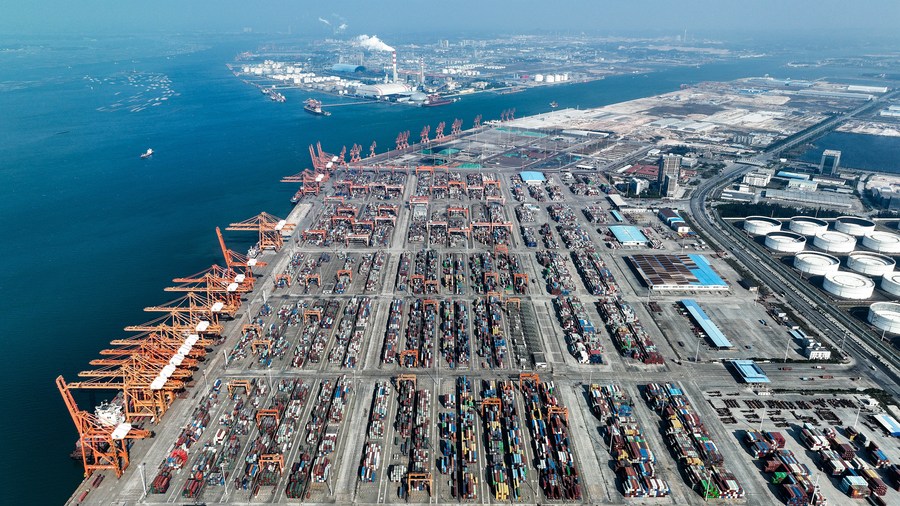
The U.S. Department of Commerce in Washington, D.C., U.S., August 5, 2020. /Xinhua
The U.S. Department of Commerce in Washington, D.C., U.S., August 5, 2020. /Xinhua
Editor's note: Azhar Azam, a special commentator on current affairs for CGTN, works in a private organization as a market and business analyst and writes about geopolitical issues and regional conflicts. The article reflects the author's opinions and not necessarily those of CGTN.
Concerning NATO's outreach in Asia, Cambodian Prime Minister Hun Sen said on June 5, "NATO only exists in the West, and now it seems to be involved in the Asia-Pacific region in various activities, bringing concerns for ASEAN," reported by Cambodian media Fresh News.
Centrality constitutes the foundation of the Association of Southeast Asian Nations (ASEAN) Charter. The concept guides the way for the bloc to play a proactive role as the main driving force for its relations and cooperation with non-members and encourages it to become the dominant regional platform to overcome challenges and engage with external partners.
U.S. President Joe Biden's "Indo-Pacific Strategy" claims to endorse ASEAN centrality and support its efforts to deliver sustainable solutions to the region's most pressing challenges; While it actually aimed to undercut the bloc's core objective by building the Quadrilateral Security Dialogue (the Quad) as a "premiere regional grouping" and bringing together Asia-Pacific allies through the AUKUS (Australia, the UK and the U.S.), a trilateral security pact that also received a strong renunciation from Indonesia and Malaysia.
These institutional initiatives including the U.S. Indo-Pacific Economic Framework for Prosperity (IPEF) – which didn't mention ASEAN centrality once – contradicted America's commitment to ASEAN and its centrality. The exclusion of Cambodia, Myanmar and Laos from the IPEF further cast doubts within the alliance about Biden's seriousness to the grouping's unity.
Unsurprisingly, ASEAN's response to the Quad, a hotbed of the U.S. strategic rivalry with China, has been muted for its tendency to challenge the alliance's centrality and securitize the region by creating an "Asian NATO."
The IPEF isn't received well within the region either where people of the major economies hold negative views about the initiative or are uncertain the initiative will lend a positive impact on the region. They remain "ambivalent" in cooperating with mini-lateral alliances such as the Quad. The institutional competition between the Quad and ASEAN is another factor that urges the regional states to draw closer to China in an attempt to hedge against the consequences of Washington's strategic rivalry with Beijing.
As ASEAN centrality barricades the success of the Biden administration's dangerous goals, it has been forcing regional states into taking sides with the U.S. against China as it did to the neutralist countries, which nevertheless resisted the pressure and maintained their neutrality, during the Cold War. In order to prevail upon the political and economic union, America's military presence is being promoted to gain its support for the U.S. subversive activities such as a "free and open Indo-Pacific (FOIP)."
The Quad diplomats are also striving to link the "ASEAN Framework of the Indo-Pacific (AOIP)" with the "FOIP." But the use of the term "Indo-Pacific" by the bloc doesn't mean the alliance is pursuing institutional bandwagoning with the Quad or supports its unruly vision. The AOIP rather responds to the four-nation alliance's presence in the region and reaffirms ASEAN's common interest to maintain peace, stability and prosperity in Southeast Asia and the wider region.

This aerial photo shows the container terminal at Qinzhou Port in South China's Guangxi Zhuang Autonomous Region, February 25, 2023. /Xinhua
This aerial photo shows the container terminal at Qinzhou Port in South China's Guangxi Zhuang Autonomous Region, February 25, 2023. /Xinhua
China's endorsement of several key elements, including independence, openness, development and cooperation, has fostered an integrated approach to regional growth and stability in 2022. This concerted effort has propelled bilateral trade to nearly $1 trillion, and with the launch of the third version of the China-ASEAN Free Trade Area (ACFTA 3.0), the cooperation is set to witness further advancements, benefitting the people across both regions.
Already 90 percent of the goods traded between China and ASEAN get zero tariff treatment. Since the ACFTA 3.0 will further reduce duties and enhance trade and investment liberalization and facilitation, it is expected to add a strong impetus to high-quality regional development including in digital economy and green transformation and complements the Regional Comprehensive Economic Partnership for open and inclusive regional growth. The recent ASEAN summit appreciated the progress made on the ongoing ACFTA 3.0 Upgrade negotiations.
In a number of meetings held so far this year, China and ASEAN states have agreed to jointly uphold multilateralism, deepen economic engagement, support ASEAN neutrality and inclusiveness, and reject the Cold War mentality and bloc confrontation. During these discussions, the Southeast Asian regional diplomats emphasized that the regional countries didn't want a conflict between China and the U.S. and sought to maintain a strong economic relationship with Beijing and others.
Yet once the U.S. failed to rally support from the region for its "Indo-Pacific strategy" and stingy IPEF that denies market access to Southeast Asia, it is endeavoring to jeopardize ASEAN centrality and foment divisions within the alliance. These sorts of coercive tactics and aggressive regional policies risk the stability of Asia-Pacific as well as have also led to a decline in the U.S. influence and credibility in the region.
ASEAN strictly practices a policy of non-intervention. In its foundational document (the 1976 Bangkok Declaration), the alliance stated it was determined to safeguard regional stability and security from external interference. It was further solidified through Article 2 of the 1976 Treaty of Amity and Cooperation which embodied universal principles including mutual respect for independence and every country's right to lead its existence free from external interference, subversion and coercion. It continues to manage its security from outside interference.
But NATO intrusion in Asia-Pacific, after the buildup of the Quad and the AUKUS, poses hard challenges to these fundamental tenets, putting ASEAN centrality in a chimera and undermining regional peace and prosperity. The opening of the so-called defensive alliance's liaison office in Japan represents more intense threats NATO is bringing to the region with possible spillover effects in the entire continent.
The regional countries cannot be swindled by the U.S. assurances that it isn't trying to create NATO in Asia-Pacific and the AUKUS is just a technology-transferring arrangement, not a security alliance. The Southeast Asian countries had long realized the AUKUS was part of a much bigger dynamic, the Quad; they remain concerned about regional security as NATO edges closer to them and the U.S. continues making efforts to militarize the region.
(If you want to contribute and have specific expertise, please contact us at opinions@cgtn.com. Follow @thouse_opinions on Twitter to discover the latest commentaries in the CGTN Opinion Section.)